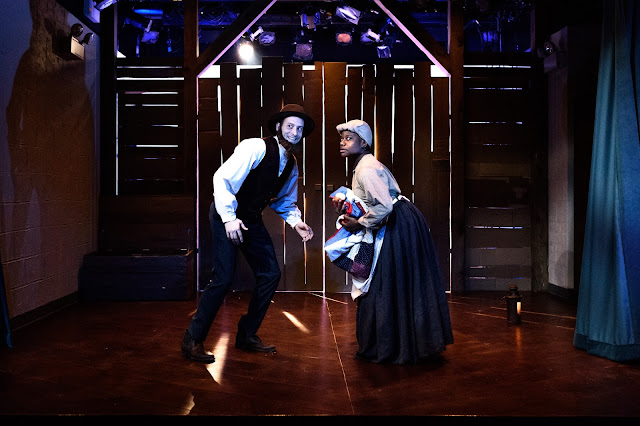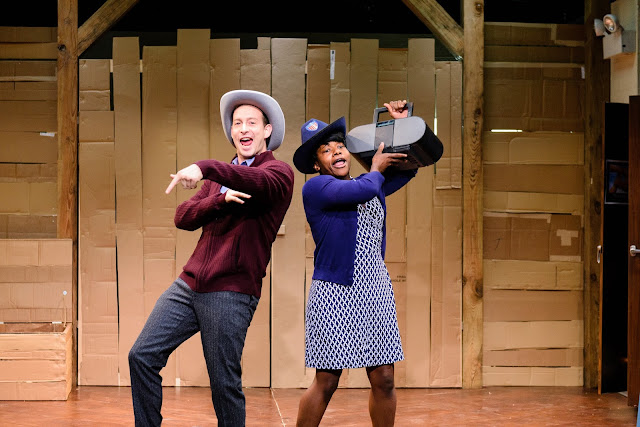“Hearing Is Believing”
 |
| Stars range from 5-1. |
Every now and then a band of brave producers risks breaking the expectations of a Broadway audience with something so strikingly unconventional it would seem more likely to be found in an Off-Broadway environment. Such is the case with The Encounter, an hour and 45-minute, one-man show (with lots of help from unseen friends) co-conceived (with Kirsty Housley), directed, and starring Simon McBurney. He’s the brilliant, 59-year-old artistic director of the innovative British theatre company Complicité, which is responsible for this production, originally seen in Edinburgh and then at London’s Barbican.
 |
| Simon McBurney. Photo: Joan Marcus. |
Inspired by Romanian novelist Petru Popescu’s Amazon Beaming (1991), an account of American photojournalist Loren McIntyre’s (1917-2003) memorable adventures in Brazil’s Amazon rainforest, The Encounter could be viewed as a remarkably well-staged radio play or audiobook. It tells of how, in 1971, McIntyre got lost in the forest, 400 miles from civilization, while searching for the presumably extinct Mayoruna, an indigenous people threatened by loggers and drillers.
 |
| Simon McBurney. Photo: Joan Marcus. |
 |
| Simon McBurney. Photo: Joan Marcus. |
Deceptively simple looking, it’s a complex and exceptionally well-conceived presentation in which McBurney—playing both himself, McIntyre, and others in the story, with additional voices supplied by unseen speakers—speaks to us while mingling self-created Foley effects with multiple prerecorded ones. McBurney--speaking in a friendly, everyday manner, despite the depth of his anthropological and philosophical subject matter--reminds us of our complicity (as per his company’s name) in creating the play’s existence through the artificial means employed.
 |
| Simon McBurney. Photo: Joan Marcus. |
What’s most unusual is that each seat in the John Golden Theatre is equipped with a headset. The audience is instructed over the PA system to make sure they hear equally well from both the right and left sides. As becomes clear, this is essential because of the binaural nature of the experience. You hear not only the narrative but the direction from which the voices and ambient sounds—including music—are coming; the sounds seem so close you may instinctively turn around or to your neighbor to see what caused them.
 |
| Simon McBurney. Photo: Joan Marcus. |
In effect, The Encounter—performed on Michael Levine’s set resembling a recording studio with a giant soundproofed wall—is a dramatic concert in which you allow the very carefully calibrated, rhythmically orchestrated voices, music, and other sounds to wash over you. The visuals boil down to McBurney dashing hither and thither as he ably uses his lithe physique to act out his story, enhanced by the expert lighting of Paul Anderson.
 |
| Simon McBurney. Photo: Joan Marcus. |
McBurney, wearing a body mic and using several other mics—including a binaural one suggesting a human head (it’s actually known as Fritz)—constantly alters his tone (or has it altered technically), volume, and accent; much is prerecorded. Often, he speaks to his little girl, whose presence is voiced by someone else and whose interruptions help relate what happened in Brazil to our own, modern reality. Gareth Fry and Pete Malkin should be frontrunners for whatever sound design awards will be presented when the season ends.
 |
| Simon McBurney. Photo: Joan Marcus. |
At one early point, McBurney asks you to close your eyes as he explains something, thus allowing a sound picture to form in your head of something not actually happening. There will be temptations during the performance to close your eyes again, especially when the narrative, regardless of how interesting much of it is, begins to wear thin. Which it definitely does. I’d advise against this because you may find yourself drifting off, overwhelmed by the convincing aural landscape into losing the thread of the storytelling. This tendency for the drama’s contents to be subsumed by its form is The Encounter’s most significant weakness.
Otherwise, this is a theatrical encounter you may not want to miss.
Otherwise, this is a theatrical encounter you may not want to miss.
OTHER VIEWPOINTS:
John Golden Theatre
252 W. 45th St., NYC
Through January 8, 2017














































